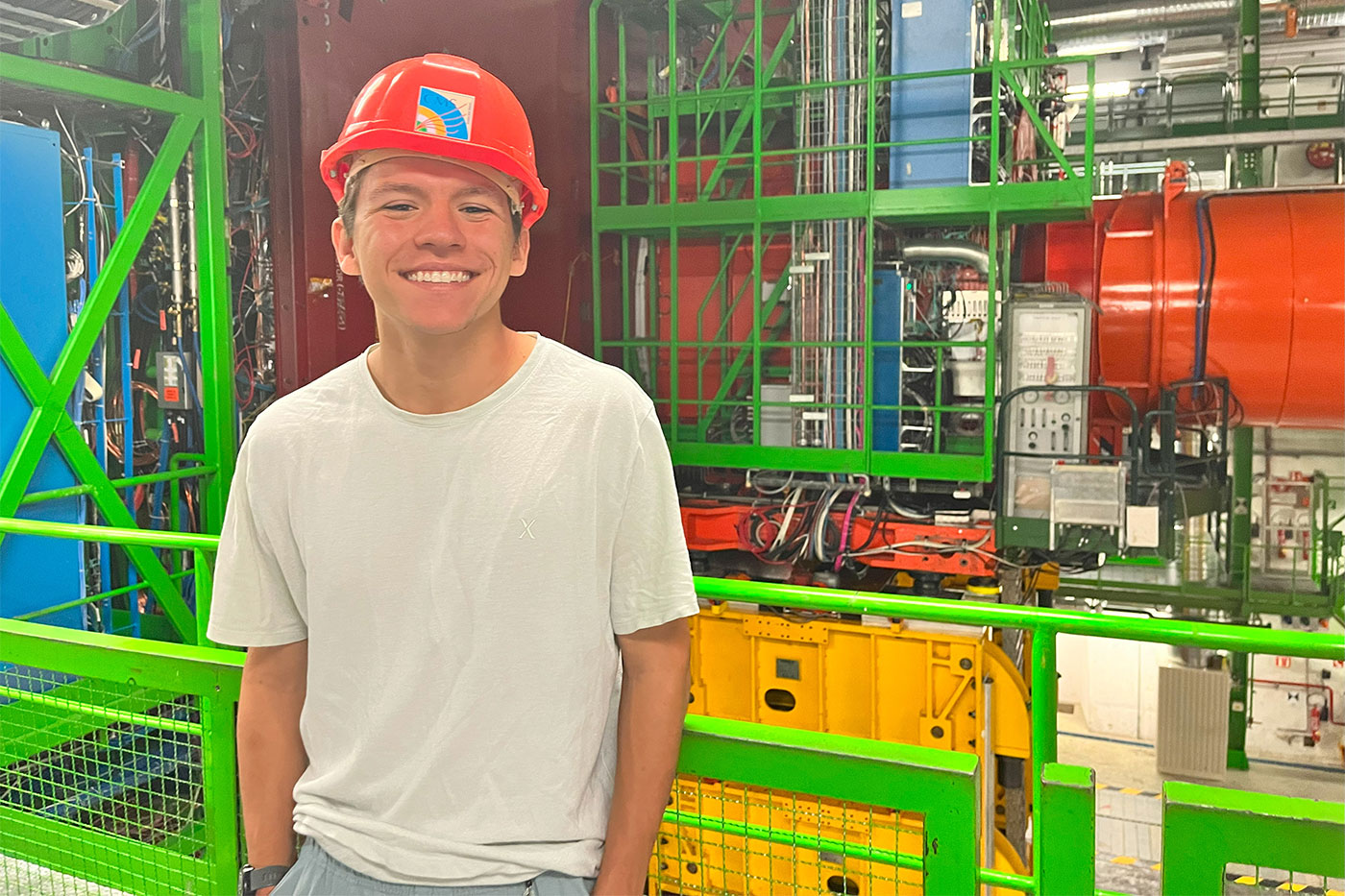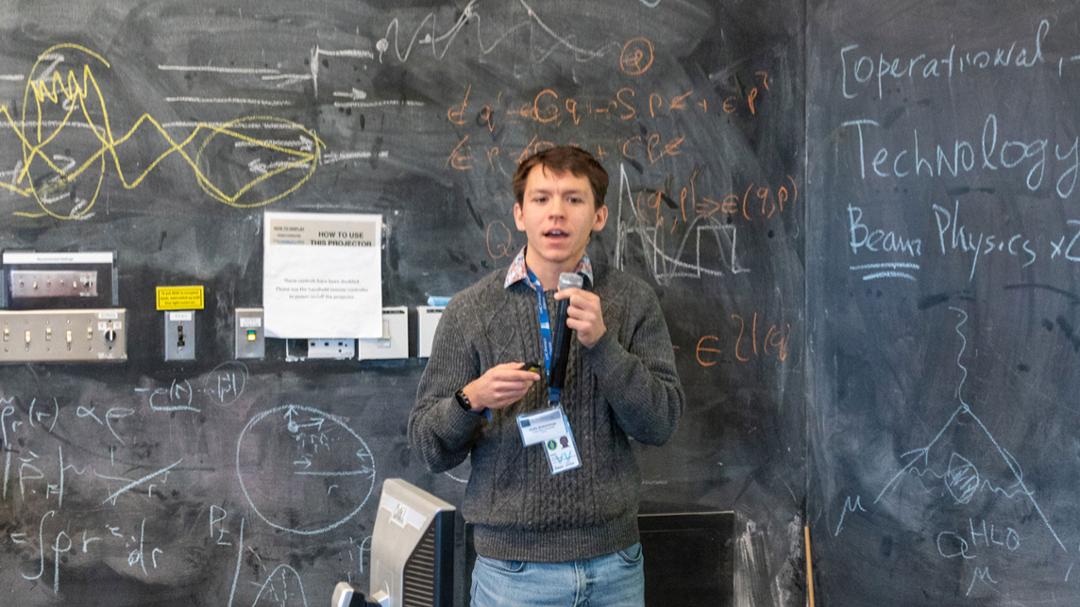Valdis Slokenbergs came to Texas Tech for hands-on experience and to help lead the next wave of creative collider innovation.
Since high school, Valdis Slokenbergs, a first-year physics doctoral student at Texas Tech University, has had a strong interest in science and solving what he calls the riddle of the universe. He grew up in Chicago, practically down the street from the Fermi National Accelerator Laboratory (Fermilab), the premier particle physics laboratory in the United States.
So, it seems like a no-brainer that Slokenbergs would end up studying particle physics.
“I grew up saying I would never do particle physics,” Slokenbergs says with a wry grin.
Slokenbergs wanted to move away from the shadow of Fermilab and enrolled at Johns Hopkins University in Baltimore. Students at Johns Hopkins are strongly encouraged to begin research work as soon as possible. Slokenbergs hoped to start on a project his first semester, but he was unsure how. Other students already seemed to have theirs lined up.
He reached out to his Introduction to Physics instructor for guidance. It turned out this professor was an expert in particle physics. Slokenbergs accepted the universe’s heavy-handed message and set out on his personal collision course with particle physics.
Slokenbergs notes that a significant aspect of particle physics is heavily computer based, akin to data science, but he didn’t have the coding skills as a first-year to make a lot of progress.
“My professor told me, ‘You’re going to do these things, and it’s going to be a pain in the butt. If you kind of enjoy this work, you’ll hopefully start to be productive within a year,’” Slokenbergs recalls.
He admits the first year was challenging, but he took advantage of having a well-established faculty member guide him through the process and develop a strong foundation in research. As Slokenbergs advanced through his undergraduate program, his enthusiasm for research never waned.
In his junior year, Slokenbergs was invited to work on a project at the European Organization for Nuclear Research (CERN). CERN is considered the global hub of particle physics and is home to the Large Hadron Collider.
“There’s a giant 27-kilometer ring underground that smashes protons together at the speed of light,” Slokenbergs says. “It’s incredible. I spent 14 weeks at CERN and realized this was what I wanted to do. I could do this work all day.”

Slokenbergs began applying to graduate programs across the country in 2024. A researcher he worked with at CERN had previously mentored Yongbin Feng and connected the two together. Feng was preparing to join Texas Tech that August as an assistant professor in the Department of Physics and Astronomy.
Slokenbergs met with Feng over video calls and once face to face (Feng was completing a postdoc at Fermilab prior to coming to Texas Tech). It didn’t take long for Slokenbergs to see the opportunity in front of him and applied to be a Red Raider.
“Working with new faculty is really exciting as a student because they are also new and just as motivated,” Slokenbergs says. “At this point in their career, they need your success as much as you need your own.”
Slokenbergs also appreciated that Feng was a recent graduate student, having earned his doctorate in 2020.
Right off the bat, Slokenbergs could tell that Feng and Texas Tech offered a more personal approach to mentorship and research. There have been times when he messaged a question or problem to Feng at midnight and received a response minutes later.
“I would sometimes feel frustrated, especially as a junior graduate student,” Feng says about his time in graduate school. “At that point, your knowledge is kind of limited. I don’t want my students to get frustrated or stuck. I know what that feels like.”
Slokenbergs has been assisting Feng with the production of silicon modules that will be installed in the Compact Muon Solenoid (CMS) experiment at the Large Hadron Collider at CERN. The CMS experiment has helped physicists search for extra dimensions and particles that could make up dark matter.
The project is a big endeavor with the plan of having the modules installed and commissioned in the next four years. Feng compares the work his lab does to a manufacturing site.
“You have to take into account the production and the need to do careful quality checks,” says Feng. “Then we need to work on wire bonding and encapsulation and do electrical tests to make sure everything is functioning as expected.”
Slokenbergs was excited at the opportunity to work on what he described as creative collider innovation at Texas Tech.
“It’s not just about saying, ‘Oh, we have all the things we need. We just need to make it bigger,’” Slokenbergs says. “But instead, let’s do new physics by doing something fundamentally different. Whether it’s a different experimental setup or technique, that’s what really interests me.”
He admits that the move to Lubbock was a bit of an eyebrow raiser for his family. For one, they had zero familiarity with the southern part of the U.S., let alone West Texas.
“They came down to help me move in August when it was about 110 degrees out,” Slokenbergs says, laughing. “There’s no shade. You look at the horizon and there’s nothing. They were like, ‘What the heck is this?’”
However, it didn’t take long for Slokenbergs and his family to feel confident in his decision to earn his doctorate at Texas Tech.
During the first semester, Slokenbergs gave a virtual talk at a working group meeting. Physicists from all over the world were on the call and provided feedback on his work.
“I realized half the people in the room were people who I had applied to work with when I was applying for graduate school,” Slokenbergs recalls. “I’m looking around, and I’m like ‘OK, I am in the room where things are happening. This is cool.’
“Other places aren’t doing a lot of the things we’re doing here. It’s not that you’re competing with these people; it’s that you’re working in parallel.”
His confidence in coming to Texas Tech has only grown as he nears the end of his first year. Slokenbergs is doing meaningful work now, but his eyes are toward his physics future.
“What I really appreciate about this program is by the time you graduate, you’re not just OK or just competent,” he says. “You’re really effective and at a level where you’re immediately contributing to productive research. This full career picture has been really nice to see.”

